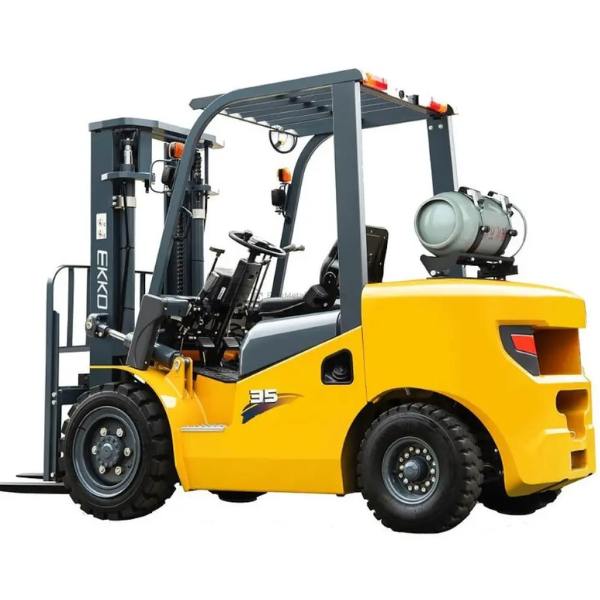Elite Metal Tools Articles
Industry news, tips, and updates on all things Elite Metal Tools
A Comparison of Propane and Electric Forklifts
History of Forklifts
1. Early 20th Century - The Beginning:
-
1917: The Clark Material Handling Company developed the 'Tructractor' in Buchanan, Michigan. It was the first internal combustion-powered industrial truck. Realizing the potential, they began selling the Tructractor to other companies, making it the first-ever forklift sold in history.
2. 1920s - Design Improvements:
-
During the 1920s, hydraulic power was introduced to forklift design, allowing for the raising and lowering of loads.
-
Yale & Towne Manufacturing introduced an electric truck with elevating forks and an outrigger, innovations that allowed for more complex lifting tasks.
3. 1930s - The Great Depression and World War II:
- The demand for material handling equipment soared during World War II, which led to vast improvements in forklift design and capabilities. They became indispensable in warehouses and ports for efficient handling of wartime materials.
4. 1950s - Expansion and Modernization:
-
The introduction of standardized pallets in the 1950s meant that forklift designs could be more consistent, allowing for broader usage and recognition.
-
Advances in technology led to the development of counterbalance forklifts, reach trucks, and turret trucks.
5. Late 20th Century - Advancements in Safety and Efficiency:
-
Forklifts underwent several design improvements for better safety features, including overhead guards, backrests, and improved hydraulic controls.
-
The electric forklift market expanded, offering cleaner operations especially beneficial for indoor use.
6. 21st Century - Technological Integration and Automation:
-
Modern forklifts now come with computerized control systems, GPS, and even automated guided systems for more efficient operations.
-
Advancements in battery technology have also led to longer-lasting electric forklifts.
-
There's been a significant move towards automation, with the rise of driverless forklift systems, especially in large warehouses and distribution centers.
Comparing Propane and Electric Forklifts:
Forklifts are essential tools in warehouses, construction sites, and many other industries, helping to move heavy goods and materials efficiently. One of the fundamental choices facing businesses in need of forklifts is the decision between propane-powered and electric-powered options. Both have their own sets of advantages and limitations.
1. Power Source:
-
Propane Forklifts: These are powered by liquid propane gas (LPG), stored in cylinders or tanks attached to the forklift.
-
Electric Forklifts: These run on electricity and are powered by large, rechargeable batteries.
2. Operating Costs:
-
Propane Forklifts: The primary cost is the propane fuel. Prices can fluctuate based on market conditions, and over time, these costs can add up. However, refueling is swift.
-
Electric Forklifts: While charging can take several hours, electricity is often cheaper than propane. The significant cost is battery replacement, which is infrequent but can be expensive.
3. Emissions and Environmental Impact:
-
Propane Forklifts: These forklifts produce emissions, although they are cleaner-burning than gasoline or diesel. Proper ventilation is necessary when using them indoors to ensure worker safety.
-
Electric Forklifts: Zero tailpipe emissions make electric forklifts environmentally friendly and ideal for indoor use without ventilation concerns.
4. Maintenance:
-
Propane Forklifts: Regular maintenance is essential, involving engine checks, oil changes, and monitoring of potential propane leaks.
-
Electric Forklifts: Generally, they have fewer moving parts than their propane counterparts, which can translate to less maintenance. Battery maintenance, however, is crucial.
5. Performance and Utility:
-
Propane Forklifts: Offer consistent power, even as the fuel tank depletes. They're versatile, suitable for both indoor and outdoor use, and can often handle rougher terrains.
-
Electric Forklifts: Performance can decrease as the battery depletes. They are better suited for smooth surfaces and are primarily recommended for indoor use.
6. Lifespan and Durability:
-
Propane Forklifts: The engine's lifespan might be shorter than that of an electric motor, given the combustion process and regular wear and tear.
-
Electric Forklifts: Electric motors can have a longer operational lifespan with proper battery care.
7. Initial Investment:
-
Propane Forklifts: Generally, the initial cost is lower than electric forklifts.
-
Electric Forklifts: Higher upfront costs, mainly due to the price of the battery and charging infrastructure. However, over time, the cost savings from reduced fuel and maintenance can offset this.
Conclusion:
There isn't a one-size-fits-all answer when choosing between propane and electric forklifts. Businesses must consider the specific needs of their operation, factoring in the environment, usage frequency, budget constraints, and long-term goals. By understanding the characteristics of each type of forklift, companies can make an informed investment that pays dividends in productivity and efficiency.

